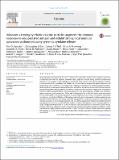Adjuvant-carrying synthetic vaccine particles augment the immune response to encapsulated antigen and exhibit strong local immune activation without inducing systemic cytokine release
Author(s)
Ilyinskii, Petr O.; Roy, Christopher J.; O'Neil, Conlin P.; Browning, Erica A.; Pittet, Lynnelle A.; Altreuter, David H.; Alexis, Frank; Tonti, Elena; Shi, Jinjun; Basto, Pamela Antonia; Iannacone, Matteo; Radovic-Moreno, Aleksandar F.; Farokhzad, Omid C.; von Andrian, Ulrich H.; Johnston, Lloyd P. M.; Kishimoto, Takashi Kei; Langer, Robert; ... Show more Show less
DownloadLanger_Adjuvant-carrying.pdf (1.715Mb)
PUBLISHER_CC
Publisher with Creative Commons License
Creative Commons Attribution
Terms of use
Metadata
Show full item recordAbstract
Augmentation of immunogenicity can be achieved by particulate delivery of an antigen and by its co-administration with an adjuvant. However, many adjuvants initiate strong systemic inflammatory reactions in vivo, leading to potential adverse events and safety concerns. We have developed a synthetic vaccine particle (SVP) technology that enables co-encapsulation of antigen with potent adjuvants. We demonstrate that co-delivery of an antigen with a TLR7/8 or TLR9 agonist in synthetic polymer nanoparticles results in a strong augmentation of humoral and cellular immune responses with minimal systemic production of inflammatory cytokines. In contrast, antigen encapsulated into nanoparticles and admixed with free TLR7/8 agonist leads to lower immunogenicity and rapid induction of high levels of inflammatory cytokines in the serum (e.g., TNF-a and IL-6 levels are 50- to 200-fold higher upon injection of free resiquimod (R848) than of nanoparticle-encapsulated R848). Conversely, local immune stimulation as evidenced by cellular infiltration of draining lymph nodes and by intranodal cytokine production was more pronounced and persisted longer when SVP-encapsulated TLR agonists were used. The strong local immune activation achieved using a modular self-assembling nanoparticle platform markedly enhanced immunogenicity and was equally effective whether antigen and adjuvant were co-encapsulated in a single nanoparticle formulation or co-delivered in two separate nanoparticles. Moreover, particle encapsulation enabled the utilization of CpG oligonucleotides with the natural phosphodiester backbone, which are otherwise rapidly hydrolyzed by nucleases in vivo. The use of SVP may enable clinical use of potent TLR agonists as vaccine adjuvants for indications where cellular immunity or robust humoral responses are required.
Date issued
2014-03Department
Harvard University--MIT Division of Health Sciences and Technology; Koch Institute for Integrative Cancer Research at MITJournal
Vaccine
Publisher
Elsevier
Citation
Ilyinskii, Petr O., Christopher J. Roy, Conlin P. O’Neil, Erica A. Browning, Lynnelle A. Pittet, David H. Altreuter, Frank Alexis, et al. “Adjuvant-Carrying Synthetic Vaccine Particles Augment the Immune Response to Encapsulated Antigen and Exhibit Strong Local Immune Activation Without Inducing Systemic Cytokine Release.” Vaccine 32, no. 24 (May 2014): 2882–2895.
Version: Final published version
ISSN
0264410X